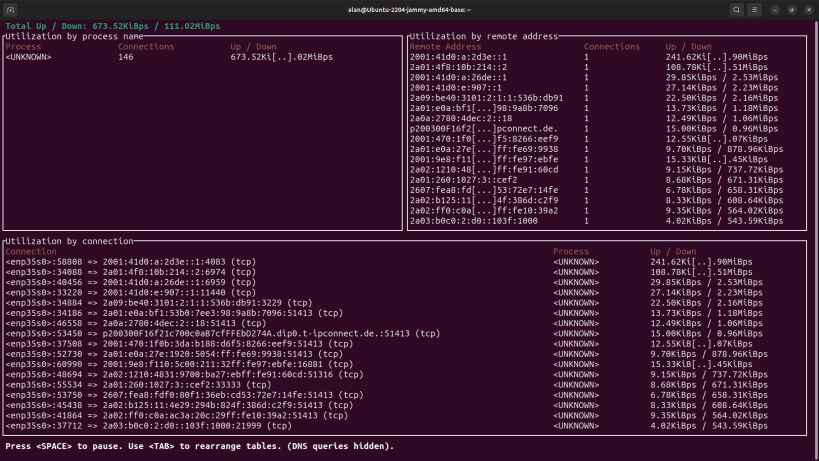

This is a CLI utility for displaying current network utilization by process, connection, and remote IP/hostname.
Note: While running, using the bandwhich command is able to see all traffic for all users on the system.
Once installed, connect the following interfaces to ensure process names are identified.
sudo snap connect bandwhich:mount-observe
sudo snap connect bandwhich:log-observe
sudo snap connect bandwhich:system-observe
Run bandwhich with sudo or as root.
sudo bandwhich
The upstream bandwhich project is currently undergoing a friendly reorganisation. Please note this issue on the upstream tracker for more details
This is an unofficial community-maintained snap using configuration from:
The upstream website can be found here:
You are about to open
Do you wish to proceed?
Thank you for your report. Information you provided will help us investigate further.
There was an error while sending your report. Please try again later.
Snaps are applications packaged with all their dependencies to run on all popular Linux distributions from a single build. They update automatically and roll back gracefully.
Snaps are discoverable and installable from the Snap Store, an app store with an audience of millions.

On Arch Linux, snap can be installed from the Arch User Repository (AUR). The manual build process is the Arch-supported install method for AUR packages, and you’ll need the prerequisites installed before you can install any AUR package. You can then install snap with the following:
git clone https://aur.archlinux.org/snapd.git
cd snapd
makepkg -si
Once installed, the systemd unit that manages the main snap communication socket needs to be enabled:
sudo systemctl enable --now snapd.socket
If AppArmor is enabled in your system, enable the service which loads AppArmor profiles for snaps:
sudo systemctl enable --now snapd.apparmor.service
To enable classic snap support, enter the following to create a symbolic link between /var/lib/snapd/snap and /snap:
sudo ln -s /var/lib/snapd/snap /snap
Either log out and back in again, or restart your system, to ensure snap’s paths are updated correctly.
To install bandwhich, simply use the following command:
sudo snap install bandwhich
Browse and find snaps from the convenience of your desktop using the snap store snap.

Interested to find out more about snaps? Want to publish your own application? Visit snapcraft.io now.